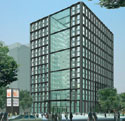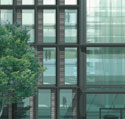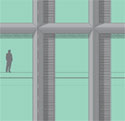Commercial Buildings Open Their Windows
Space planning and building management are factors that can support or thwart the effectiveness of natural ventilation systems. The spatial flexibility of a large office floor, typical of so much office construction in the U.S. that can be reconfigured constantly for ever-changing user needs, is simply not conducive to the effective employment of user-controlled natural ventilation. The interiors of these floors will benefit less, if at all, from naturally ventilated skins. "If you are 50 feet away from an operable window, you won't feel much of its effect," observed Bisel. "Some enlightened companies reverse the typical office layout and place open-plan offices at the perimeter and private ones at the interior." But those interior offices will not benefit from open windows on the perimeter. Narrow floor plates, as seen in the RWE Tower and CYTS Plaza, lead to smaller units of space in which user consensus over thermal comfort will be easier to attain, and the smaller units of space can be more easily zoned and coordinated with mechanical systems for energy management.
McLauglin points out that natural ventilation is most successful when the entire building has an integrated design for energy management, most notably in the building details that reduce the overall heat gain in a building. At RWE, for example, the cavity blinds act as a shading device to prevent solar gain; the air circulation in the cavity removes the warm air that the blinds absorb before it can reradiate to the interior. Increasing the opportunities for introducing natural ventilation into nonresidential high-rise construction will continue to face design complications, but the challenges are well worth it for the sharp rise in human comfort and the potential for significant energy savings.
Endless growing season
The newly created Nolen Greenhouses for Living Collections at the New York Botanical Garden in the Bronx arguably provide the most sophisticated facility for growing plants in the U.S. Designed by New York−based Mitchell/Giurgola Architects (with Joseph R. Loring & Associates, Severud Associates, and Langan Engineering and Environmental Services), the greenhouses represent a complex synthesis of high and low technologies, in order for hundreds of thousands of plants to thrive and propagate under an acre of glass.
"The greatest challenge was to retain and enhance the unique natural site conditions of this area of the Botanical Garden-rock outcroppings, beautiful specimen trees, and lawns, while satisfying the strict solar orientation requirement of the greenhouses, and providing convenient and logical visitor and service access," explains Mitchell/Giurgola partner James R. Braddock, AIA. "Also, by establishing an appropriate architectural expression for the headhouse [administration and visitors center], orchestrating its massing, and creating a counterpoint between the glass volumes of the greenhouses and the solid volumes of the headhouse, our goal was to make the entire complex more than just an efficient solution to a series of technical problems."












